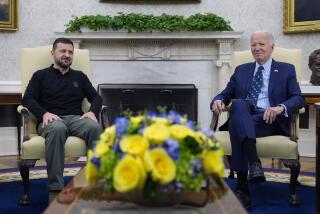Sandinistas Reportedly to Get More Soviet Copters
- Share via
MANAGUA, Nicaragua — The Soviet Union has agreed to expand the Sandinista army’s helicopter fleet amid evidence that U.S.-backed rebels shot down at least two of the choppers, Western intelligence sources said Monday.
The reported deal calls for shipment of 12 to 18 new MI-17 troop-carrying helicopters in the coming months.
Sandinista officials asked for the helicopters after thousands of rebels began infiltrating Nicaragua from Honduras last December in a new offensive.
The rebels claim to have shot down seven helicopters since December after setting ambushes with SA-7 anti-aircraft missiles supplied by the CIA under the current fiscal year’s $100-million U.S. program of military and other aid to the contras.
The destruction of helicopters, which are a key element of the Sandinista army’s military strategy, would mark the first major success in the contras’ renewed campaign against the Marxist-led government here.
After the latest rebel claim, on Friday, the Nicaraguan Defense Ministry denied having lost any helicopters.
“All these claims are part of a propaganda campaign by the counterrevolution to appear to be having a resurgence, which is false,” the ministry’s spokeswoman, Capt. Rosa Pasos, said.
U.S. intelligence analysts consider most rebel field reports unreliable. But after reviewing the claims and other evidence, they said there are “multiple credible reports” that an MI-24 gunship and at least one other chopper were downed.
“There are reports that as many as four have been lost, but they aren’t conclusive,” said a State Department official in Washington. “We’re reasonably confident that two have been shot down.”
The official did not say when or where the two helicopters are supposed to have been downed.
Diplomats in Managua say the Sandinistas got 52 Soviet helicopters, mostly MI-17s, in three previous shipments over the past two years. The acquisitions dealt a severe blow to the contras’ military effort.
The copters can quickly move anti-guerrilla forces and equipment to battle zones. The MI-17 can fly up to 32 men at speeds of over 150 miles per hour, and the sophisticated MI-24s can direct rocket and machine-gun fire against ground units.
The Sandinistas, who face a shortage of trained pilots, are said to have asked for the new helicopters more to offset recent or anticipated losses than to significantly expand their air power.
“The Sandinistas have to keep the pipeline flowing,” a diplomat in Managua said. “They have evidently lost some helicopters and no doubt expect to lose more.”
Meeting another Sandinista request, the Soviets recently delivered a number of radar-controlled anti-aircraft guns to try to shoot down rebel supply planes, according to a Western observer here.
The Defense Ministry declined to comment on either reported deal.
The new helicopters reportedly are to arrive before September, when the U.S. Congress is expected to vote on a request by the Reagan Administration’s for $105 million in new aid to the rebels.
Rebel leaders say they need to show impressive battlefield gains during their growing offensive to have a chance of getting any new aid.
With the newly acquired SA-7s, contra teams have set ambushes along helicopter flight paths, trying to keep the Soviet copters out of direct combat.
Contra officials expect to acquire more-sophisticated Redeye missiles with a $40 million allotment of the current U.S. aid package that was released last month.
The rebels have several hundred sappers trained in the United States to parachute into Nicaragua and attack CIA-selected targets, including helicopters parked on the ground.
In the past four weeks, these demolition squads have concentrated almost exclusively on sabotage of Nicaragua’s electric power system. They have toppled 11 transmission pylons, blacking out towns near Nicaragua’s northern and southern borders, according to the government.
Nicaraguan army officials acknowledge that more than 6,000 rebels are inside the country. Western officials put the number at 13,000 and say that rebel planes based in Honduras are dropping supplies to them three to four times a week.
The Sandinistas have intercepted only one such drop this year, nearly four tons of explosives, ammunition and cash tied to unmanned parachutes.
“Those flights cannot pass over Nicaragua without us knowing,” Capt. Ricardo Wheelock, the chief of army intelligence, said. “But we lack interceptor planes to stop them.”
He said that such fighters are “too expensive” for Nicaragua. The United States has threatened to destroy any jet fighter that the Sandinistas obtain.
The new anti-aircraft guns reportedly obtained by Nicaragua, the ZSU-23-4, could prove effective against rebel supply planes, Western observers believe.
The guns can maneuver automatically into any firing position from the back of light tanks and are far more mobile than the older carriage-mounted KS-19s now used by the Sandinista army. The number of ZSU-23-4s delivered was not reported.
Times staff writer Doyle McManus in Washington contributed to this story.
More to Read
Sign up for Essential California
The most important California stories and recommendations in your inbox every morning.
You may occasionally receive promotional content from the Los Angeles Times.









